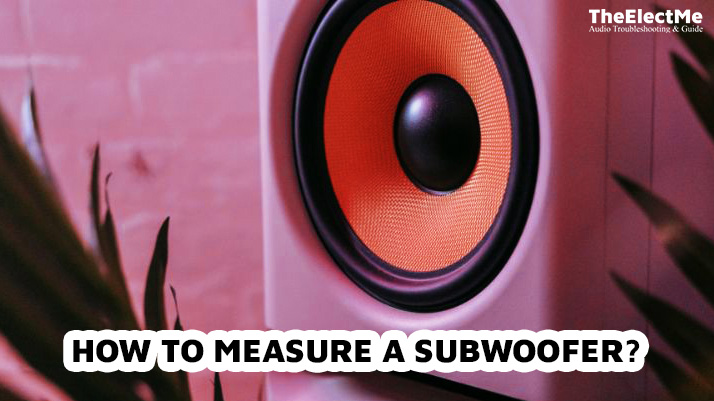What is the best position for subwoofer in car? Sometimes, I wondered why the bass in my car’s audio system did not sound as good as I wanted. After some research, the positioning of my subwoofer could have been more optimal. A subwoofer is an essential component for any car audio system. Its placement can significantly affect the quality of sound in your vehicle.
Because the position of a subwoofer can change how sound waves travel and interact with the car’s interior, the right spot for a subwoofer can take your car’s audio experience from good to great. The right one, however, can lead to solid bass or uneven sound distribution. So, knowing the best position of subwoofer in car is crucial for the best sound.

With the proper knowledge and approach, anyone can find the best position for a subwoofer in car.
Whether you’re a seasoned audiophile or a casual listener, this information will help enhance your car audio experience.
Let’s explore the five best positions for a subwoofer in a car.
5 Best Position For Subwoofer In Cars
To find the best spot for your subwoofer, consider both the technical and practical aspects. Here are five positions that have been proven to work well for most car audio systems:
Position No. 1: In the Rear Seat
The rear seat of a car is typically located behind the driver and front passenger seats. It is often overlooked, but it is an excellent choice for multiple reasons when deciding where to place a subwoofer.
You’ll need a box that fits snugly into the seat space to position a subwoofer in the rear seat.
One of the main benefits of placing the subwoofer in the rear seat is that it brings the bass closer to the listeners.
This positioning enhances sound distribution, creating a more immersive audio experience for everyone in the car.
Moreover, placing the subwoofer in the rear seat can enhance bass production. Feeling the bass up close enhances the listening experience, especially for bass enthusiasts.
You’ll need a box that fits snugly into the seat space to position a subwoofer in the rear seat.
Below are steps for installing a subwoofer in the back seat.
- Measure the space under your rear seat and purchase a custom-fit subwoofer box.
- Disconnect the negative terminal of your car battery to avoid any electrical accidents during installation.
- Install the subwoofer box in the designated spot, ensuring proper fitment and secure mounting.
- Connect the amplifier’s power, ground, and remote wires to the subwoofer.
- Reconnect the car battery’s negative terminal and test the new bass placement. Turn on the audio system for optimal performance.
Position No. 2: Facing the Back of the Car
The direction in which a subwoofer faces can also significantly impact sound quality. One common strategy is to position the subwoofer so that it faces towards the back of the car. This method utilizes the car’s interior acoustics to enhance bass and overall sound quality by leveraging its structure.
When the subwoofer faces the car’s rear, the sound waves produced by the subwoofer first hit the back. From there, they bounce off and spread outwards towards the rest of the vehicle. This creates a ‘sound wave ricochet’ effect, evenly distributing bass frequencies in the car.
Moreover, having the subwoofer face the rear can also help to reduce unwanted vibration. This setup reduces bass vibration in the car’s interior, which can sometimes cause unwanted rattling noises.

Here are the steps for setting up a subwoofer that faces the back of the vehicle:
- Purchase a custom-fit or universal subwoofer box that fits your car’s specifications.
- Disconnect the negative terminal of your car battery to avoid any electrical accidents during installation.
- Place the subwoofer box in the designated location, ensuring it faces the car’s rear.
- Connect the amplifier’s power, ground, and remote wires to the subwoofer.
- Reconnect the car battery’s negative terminal and test the audio system for optimal bass performance.
Position No. 3: In the Trunk Area
The trunk area at the car’s rear is a common and popular location for placing a subwoofer. This is especially true for sedans and coupes with enclosed trunk spaces.
The trunk area offers ample space, allowing larger subwoofers or multiple units to be installed. It keeps the subwoofer out of sight, which can be a plus for security reasons.
Placing the subwoofer in the trunk can reduce unwanted vibrations in the passenger cabin.
Sound might be more complex than other positions, as it has to pass through the back seats. Access to the trunk for storage purposes can be compromised. Some bass may be lost or silenced due to the trunk’s insulation.
But for some reason, your one-car speaker not working if it doesn’t sound might be more complex than other positions, as it has to pass through the back seats. How to troubleshoot it, click the link to tackle this thorny issue.
To place a subwoofer in the trunk area, follow these steps:
- Choose the proper enclosure. Choose between sealed, ported, or bandpass enclosures depending on your trunk space and desired sound.
- Position the subwoofer. Experiment with different positions in the trunk to see where it sounds best. Typical placements are against the rear seat or towards the side of the trunk.
- Secure the subwoofer. Once you’ve found the optimal spot, secure the subwoofer box to the trunk floor using brackets or straps. This prevents it from moving while driving.
- Connect the subwoofer. Connect car stereo wires to the subwoofer, ensuring they’re safely tucked away in the trunk without interference.
Position No. 4: Under the Rear Seat
The area under the rear seat is located directly beneath the seat in the back of the car. This spot is often missed but perfect for a subwoofer, especially in roomy trucks or large SUVs.
Placing a subwoofer under the rear seat can produce more intense bass sounds due to the proximity to the listeners. The bass doesn’t have to travel far, which can result in a more direct and consequential sound. This position uses the cabin’s acoustics, with sound waves bouncing off the floor and walls, filling the vehicle with deep bass.
However, this location does have its drawbacks. Due to limited space, it requires a shallow-mount subwoofer, and the installation process can be more complex.
But if done correctly, the result can be an impressive audio experience.
Due to limited space, it requires a shallow-mount subwoofer
To place a subwoofer under the rear seat, follow these steps:
- Measure the space. You must ensure enough room for the subwoofer and its box. Remember to leave some clearance for the seat to move and for ventilation.
- Choose the right subwoofer. Look for a shallow-mount model that fits the available space.
- Build or buy an enclosure. The enclosure should fit snugly under the seat without obstructing any seat functions.
- Position and secure the subwoofer. Place the subwoofer and its enclosure under the seat, ensuring it’s secure and won’t shift during driving.
- Connect the subwoofer. Connect the wires from your car’s audio system to the subwoofer. Make sure they’re safely stowed and clear of seat mechanisms.

Position No. 5: Inside the Car Door
The inside of the car door, specifically the lower part, is another possible location for installing a subwoofer. This area is usually for smaller speakers but can fit a compact subwoofer with the right equipment.
Installing a subwoofer in the car door can create a more immersive stereo image, as the sound originates closer to the listener. However, this setup has its challenges. The limited space, so the subwoofer needs protection from dust, moisture, and impacts.
To place a subwoofer inside the car door, follow these steps:
- Measure the available space. Ensure the subwoofer has enough room and the door can close properly after installation.
- Choose the right subwoofer. You’ll need a compact, shallow-mount model that fits within the door panel.
- Remove the door panel. You must carefully remove the interior door panel to access the speaker location.
- Install the subwoofer. Mount the subwoofer in the existing speaker hole or create a new one if necessary. Ensure the subwoofer is securely fastened and won’t rattle during driving.
- Reinstall the door panel. After installing the subwoofer, replace the door panel, ensuring all clips and screws are securely fastened.
- Connect the subwoofer. Connect car audio system wires to the subwoofer, ensuring they’re safely tucked away without interfering with door mechanisms.
Remember, this is a more complex installation process that may require professional assistance. Always check your vehicle’s warranty and consult a professional before modifying your car’s interior. Car owners also place a subwoofer on the shelf at the back of their car. How to place a subwoofer in your car? Curious click on the link.
Final Thoughts – Best Position For Subwoofer In Car
In short, the ideal car subwoofer placement depends on personal preference, available space, and desired sound. Experimenting with different positions can help you find the optimal spot for your car’s subwoofer.
Choose the proper enclosure & subwoofer size, secure it properly, and connect to your audio system. Installing and maintaining a subwoofer can improve your car’s audio system, enhancing your driving experience.
Before installing a subwoofer in your vehicle, research and plan. Enjoy the added powerful bass it brings to your music.



